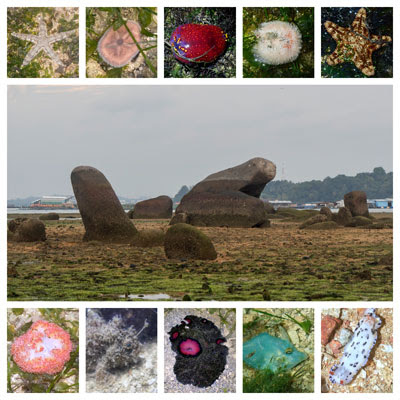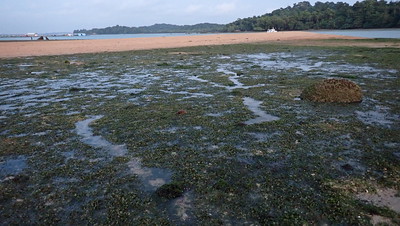Pulau Sekudu is off limits since 2007 and requires special permission from NParks. Thanks to NParks for permission and support to do these predawn low spring tide surveys of the island.
It was great to see many colourful patches of large, well grown sponges in a wide variety. Growing on the lower portions of the rocky areas (where they are only exposed at very low tides). This is similar to what we saw in Jun 2022 and Dec 2021, which was an improvement over our surveys in 2020.
Today, I saw even more sea fans than on our last survey in Jun 2022. Although the colonies were small, they were healthy. Most of them were Candelabra sea fans but there were also other kinds. I only saw one of what should be many small Boulder pore coral colonies on the arm of the lagoon. I also saw the Pock-marked coral colony and Boulder sandpaper coral (both of which I have seen here before in the past). There were also patches of Zebra coral on the rocks near the high shore, as is common on our Northern shores.
Like most of our northern shores, the stars of this shore are the echinoderms. I saw 6 Knobbly sea stars on the arm of the lagoon (both on the outer side, on the middle of the arm and on the lagoon side of the arm). Most were old grizzled grandmothers (about 30cm), I only saw one medium sized ones. I saw 3 on our last survey in Jun 2022. It was good to see Biscuit sea stars, which were missing on our 2020 and 2021 surveys. I saw an Eight-armed luidia sand star and the rest of the team saw a Common sea star - which we have not seen here since 2016!
The usual common 'northern' sea cucumbers were also seen: Thorny sea cucumber, Pink warty sea cucumber (though these two not as plentiful as seen on Changi), Orange sea cucumbers. Today, I saw many Big synaptid sea cucumbers. The long time resident Diadema sea urchin is still there - plus some tiny Diadema were seen too! As well as many White sea urchins, and few Black sea urchins. The rest of the team also saw special sand dollars and heart urchins.
There were still many Haddon's carpet anemones everywhere on the shore. Also some Swimming anemones and some Posy anemones. I saw many Flowery sea pens, and some Spiky flowery soft corals - these were more abundant on Chek Jawa during our most recent survey in Jun 2023.
An intriguing find was the Watering Pot clam - which is a bivalve that looks like its scientific name. The Yellow cuskeel is an odd-looking fish that I often see here. There were also the usual common nudibranchs, crabs and hermit crabs, and snails.
Here's a compilation of all the Knobbly sea stars seen by the team. These sea stars have unique colours, and patterns of knobs. So it was (relatively) easy to omit duplicates. In total, it seems the team's wide survey saw 26 of these sea stars, including 3 that were relatively young. A good sign that there is some regeneration of the sea star population.
 |
| Montage of photos by the team. Links to their albums below. |
The rest of the team's other special sightings include Common sea stars, which we have not seen here for some years. A tiny Frogfish! Also special sand dollars, sea cucumbers and heart urchins. There were also slugs and flatworms. And a lovely daylight shot of the huge rock in the shape of a frog on the island. Someone had helpfully added eyes and a smile on the rock. There is a legend about an elephant, a pig and a frog and how they formed Pulau Sekudu and Pulau Ubin. More here.
 |
| Montage of photos by the team. Links to their albums below. |
The seagrasses were growing lush, green and clean (no epiphytes)! Lots of Spoon seagrass (both small and large leaf blades). There were many patches of Fern seagrass and Needle seagrass. Serrated ribbon seagrass are still growing in sparse patches from the mid-water mark to the low tide line. I saw only one clump of Tape seagrass. It had leaves that were only about 50cm long and was producing many female flowers.
What is the fate of Pulau Sekudu?
Chek Jawa and Pulau Sekudu is slated for reclamation in the Long-Term Plan Review. The plan includes a road link (black line) from the mainland jumping off at Punggol, crossing to Pulau Ubin through Chek Jawa to jump off to Pulau Tekong before circling back to the mainland on Changi East. Proposed reclamation (in yellow) will bury Pasir Ris shores, Pulau Sekudu and Chek Jawa as well as a large stretches of Changi Beach.
The Singapore Blue Plan 2018
Among the Proposed Areas for Immediate Conservation Priority, the Singapore Blue Plan 2018 proposes that the intertidal and subtidal marine areas of Pulau Ubin to be designated Marine Reserve.
The proposed area would include Tanjung Chek Jawa, the largest known intertidal area in northern Singapore. Considered one of the richest in Singapore, Chek Jawa comprises many adjacent ecosystems: coastal hill forest, mangrove areas, rocky shores, seagrass meadows, coral communities, and sandy areas. Chek Jawa remains an icon of celebration and hope for many Singaporeans since its reprieve from reclamation in 2001.
DOWNLOAD the Plan, SUPPORT the Plan! More on the Singapore Blue Plan 2018 site.
Photos by others on this survey
Richard Kuah
Kelvin Yong
James Koh
Tommy Arden
Marcus Ng
Chay Hoon
Jianlin Liu











